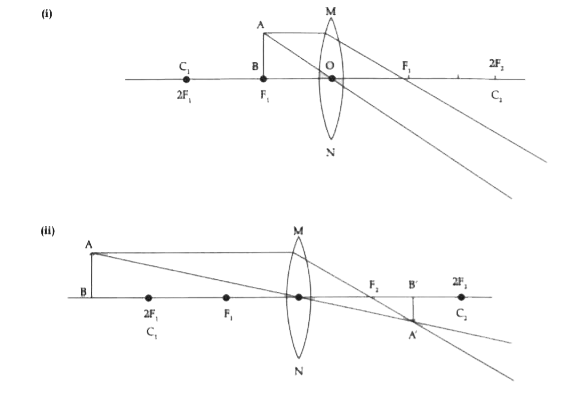Draw the ray diagrams for the image formation in a convex lens when an object is placed
(i) at focus F1
(ii) beyond 2F1
The following Reaction are
Topper's Solved these Questions
- PERIODIC CLASSIFICATION OF ELEMENTSBOOK - OSWAAL PUBLICATIONCHAPTER - PERIODIC CLASSIFICATION OF ELEMENTSEXERCISE - NCERT CORNER - TEXTBOOK EXERCISES
10 Videos
- SSLC KARNATAKA JUNE 2020 CLASS -X BOOK - OSWAAL PUBLICATIONCHAPTER - SSLC KARNATAKA JUNE 2020 CLASS -X EXERCISE - VI. ANSWER THE FOLLOWING QUESTION
1 Videos
Similar Questions
Draw neat and well labelled ray diagrams for image formation by a convex lens when an object is
at focus F1
View SolutionDraw ray diagram showing the image formation by a convex lens when an object is placed at the focus of the lens.
View SolutionDraw ray diagram showing the image formation by a concave lens when an object is placed at the focus of the lens.
View SolutionDraw neat and well labelled ray diagrams for image formation by a convex lens when an object is beyond 2F1
Also state the position , nature and size of the image relative to that of the object.
View SolutionDraw neat and well labelled ray diagrams for image formation by a convex lens when an object is
at 2F1
View SolutionDraw ray diagram showing the image formation by a convex lens when an object is placed at twice the focal length of the lens.
View SolutionDraw ray diagrams showing the image formation by a concave lens when an object is placed
(a) between focus and twice the focal length of the lens
(b) beyond twice the focal length of the lens
View SolutionDraw ray diagrams showing the image formation by a concave lens when an object is placed
(a) between focus and twice the focal length of the lens
(b) beyond twice the focal length of the lens
View SolutionDraw neat and well labelled ray diagrams for image formation by a convex lens when an object is
at infinity
View SolutionDraw neat and well labelled ray diagrams for image formation by a convex lens when an object is between focus F1 and optical centre O.
Also state the position , nature and size of the image relative to that of the object.
View Solution
